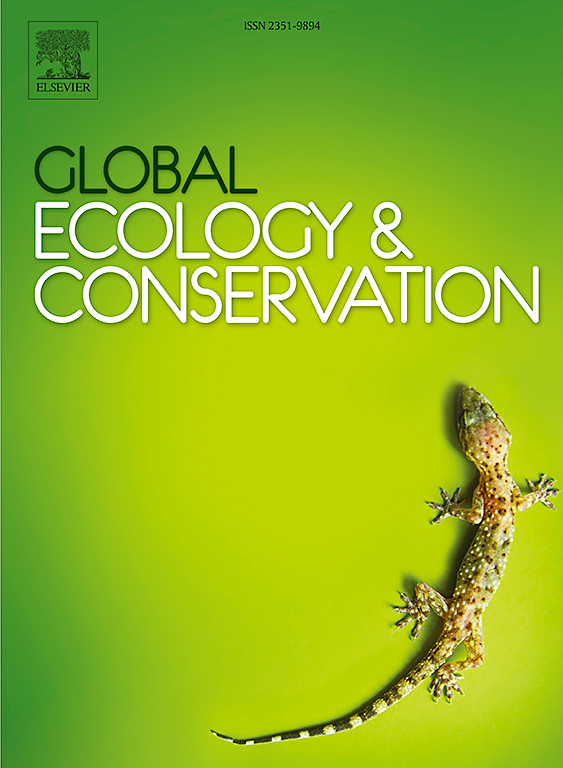Ecological responses of Orientallactaga sibirica: Variations in body size and trophic niche across changing habitats
IF 3.4
2区 环境科学与生态学
Q1 BIODIVERSITY CONSERVATION
引用次数: 0
Abstract
In arid ecosystems, precipitation and temperature are two key factors, with altitude further shaping habitat conditions through its regulatory effects on temperature. These environmental variables interact with habitat resource distribution, which significantly affect animal morphology, behavior, and ecological interactions, including food availability, body size, migration patterns, competitive dynamics, and shelter utilization. However, existing research predominantly focuses on small-scale and localized climatic impacts, lacking comprehensive explanations for large-scale, with multiple ecological responses. As a widely distributed rodent in arid environments, Orientallactaga sibirica serves as an effective bioindicator of climate and habitat resource variations. This study investigates the effects of climate change and habitat resource heterogeneity on O. sibirica by analyzing its body size and trophic niche through field surveys and stable isotope techniques. Climate data, altitude, and fractional vegetation cover (FVC) were integrated to explore the underlying mechanisms driving these variations. The results reveal significant variability in O. sibirica body size across different habitat conditions. Individuals inhabiting the mid-temperate semi-humid zone, the plateau temperate semi-arid zone, and high-altitude regions exhibited significantly larger body sizes compared to those in other climatic regions. Body size demonstrated a significant linear decline with increasing mean annual temperature, while it exhibited a significant linear increase with rising altitude, annual precipitation, and FVC. The trophic niche width of O. sibirica varied across habitat types, being widest in the warm-temperate semi-humid zone and at mid-altitudes. Segmented structural equation modeling revealed that elevation and mean annual temperature exerted significant negative effects on O. sibirica body size by affecting FVC, whereas annual precipitation had a significant positive effect on body size, mediated through FVC. These results highlight the complex interactions between climatic factors and habitat conditions in shaping the morphological and ecological adaptations of O. sibirica, providing valuable insights into species responses to environmental change in arid ecosystems.
西伯利亚东北毛蚶的生态响应:不同生境中体型和营养生态位的变化
在干旱生态系统中,降水和温度是两个关键因素,海拔通过其对温度的调节作用进一步塑造了生境条件。这些环境变量与栖息地资源分布相互作用,显著影响动物形态、行为和生态相互作用,包括食物供应、体型、迁徙模式、竞争动态和住所利用。然而,现有的研究主要集中在小尺度和局部的气候影响上,缺乏对大尺度、多生态响应的综合解释。作为一种广泛分布于干旱地区的啮齿动物,西伯利亚东方足是气候和生境资源变化的有效生物指示因子。本文通过野外调查和稳定同位素技术,分析了西伯利亚大蠊的体型和营养生态位,探讨了气候变化和生境资源异质性对西伯利亚大蠊的影响。结合气候数据、海拔和植被覆盖度(FVC)来探索驱动这些变化的潜在机制。结果表明,在不同的生境条件下,西伯利亚大蠊的体型存在显著差异。生活在中温带半湿润区、高原温带半干旱区和高海拔地区的个体体型明显大于其他气候区。体大小随年平均气温的升高呈显著的线性下降,随海拔、年降水量和植被覆盖度的升高呈显著的线性增加。不同生境类型的西伯利亚石杉的营养生态位宽度不同,在暖温带半湿润区和中海拔地区最宽。分割结构方程模型表明,海拔高度和年平均温度通过影响植被覆盖度对西伯利亚野蝗体长产生显著的负向影响,而年降水量通过植被覆盖度对西伯利亚野蝗体长产生显著的正向影响。这些结果强调了气候因子和栖息地条件之间的复杂相互作用在塑造西伯利亚大蠊的形态和生态适应中,为干旱生态系统中物种对环境变化的响应提供了有价值的见解。
本文章由计算机程序翻译,如有差异,请以英文原文为准。
求助全文
约1分钟内获得全文
求助全文
来源期刊

Global Ecology and Conservation
Agricultural and Biological Sciences-Ecology, Evolution, Behavior and Systematics
CiteScore
8.10
自引率
5.00%
发文量
346
审稿时长
83 days
期刊介绍:
Global Ecology and Conservation is a peer-reviewed, open-access journal covering all sub-disciplines of ecological and conservation science: from theory to practice, from molecules to ecosystems, from regional to global. The fields covered include: organismal, population, community, and ecosystem ecology; physiological, evolutionary, and behavioral ecology; and conservation science.
 求助内容:
求助内容: 应助结果提醒方式:
应助结果提醒方式:


